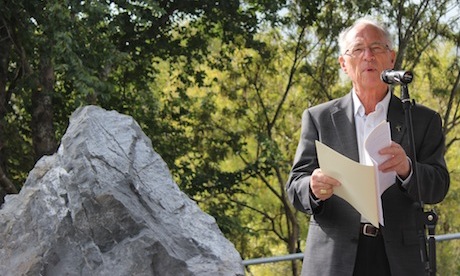Bishop Peter Cullinane was among speakers remembering those who have died at work, at a commemoration service for Workers Memorial Day in Palmerston North on Sunday 28 April.
Bishop Peter said that each one of the “terrible statistics” of workplace deaths, injuries and illnesses represented the suffering of individuals and families.
He said human wellbeing was not simply a matter to be addressed as a side-issue after economic planning had been done, but needed to be factored in before the profits were calculated.
“The very starting point of all economic and social planning needs to be the innate dignity of the human being. Because when you start there, you’ve got a way of calculating the real value of human labour,” said Bishop Peter.
“And if you don’t start that calculation starting from the innate human dignity of the human person, it’s no wonder that you end up concluding that human labour is only a cost to be reduced as far as possible.”
Other speakers recalled the recent deaths of clothing workers in Bangladesh, ordered back to work in a building which subsequently collapsed, and of the 29 miners who died at Pike River. On average, one New Zealand worker dies each week in a workplace accident.
Findings from the Workplace Health and Safety Taskforce, which was released on Tuesday concluded that workplaces across the country are “not fit for purpose” and called for “urgent, broad-based change”.
It said the country’s health and safety system has “a number of critical weaknesses” and “needs major systemic changes to save lives”.
However, on Wednesday Statistics New Zealand put a freeze on its release of work-related injury indicators because of “quality concerns”.
The number of reported deaths from 2000 till 2011 was too high because in cases of multiple injuries the fatality was counted more than once.
The error was discovered before a scheduled release in November, and Statistics NZ said its previous figures should not be used until they were reviewed and revised.
Workplace Health and Safety Taskforce report’s conclusions are:
- A stand-alone health and safety regulator – This would provide a single point of accountability and be best placed to promote and regulate workplace health and safety, and co-ordinate educational and compliance activities.
- Modern legislation – The current legislative environment is complex, confusing and outdated, with significant gaps in coverage. New Zealand needs new law that is comprehensive in its coverage and provides greater certainty for all participants.
- Tripartism operating at all levels – The Government and employer and worker representative bodies need to provide joint oversight of the system.
- Leadership and culture change – New Zealanders need to have a much lower tolerance of risky, unsafe and unhealthy work. A major national public awareness campaign is needed to shift attitudes. More people need to show leadership on workplace health and safety.
- Increased resourcing for new agency – Priorities include standard-setting to clarify expectations of all participants in the system; compliance support to lift the capacity and capability of the inspectorate; and in occupational health, which has suffered from significant under-investment and faces unique, complex challenges.
Source
